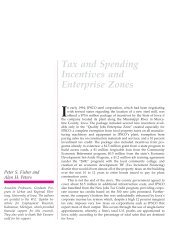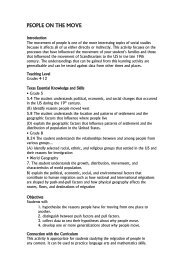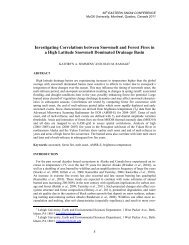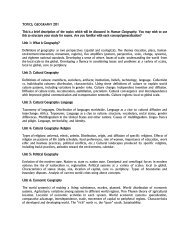Texas Social Studies Framework - Department of Geography ...
Texas Social Studies Framework - Department of Geography ...
Texas Social Studies Framework - Department of Geography ...
You also want an ePaper? Increase the reach of your titles
YUMPU automatically turns print PDFs into web optimized ePapers that Google loves.
Chapter 3: Making Connections through <strong>Social</strong> <strong>Studies</strong><br />
Other subjects can also contribute to a unit on the U.S.<br />
Constitution. Mathematics provides the tools to create<br />
time lines, gather national and regional statistics, and<br />
create graphs to interpret the data. A unit can provide<br />
students with the opportunity to apply English language<br />
arts and reading skills <strong>of</strong> research and writing as students<br />
consider the material produced by convention delegates<br />
and the audiences addressed. Connections with fine arts<br />
provide a means to consider the influence <strong>of</strong> national and<br />
international art, literature, and culture on the writers <strong>of</strong><br />
the constitution and the citizens <strong>of</strong> the United States. The<br />
sectional differences Thomas Jefferson described when<br />
he compared people in the North to people in the South<br />
(Bowen, 1986, p. 92) become easier to understand when<br />
students consider point <strong>of</strong> view, differences in science<br />
and technology, and fine arts (see Figure 10).<br />
High School World History<br />
The growth <strong>of</strong> large cities near the end <strong>of</strong> the Neolithic<br />
Age marks a major turning point in world history.<br />
Examples usually included in a study <strong>of</strong> this era are the<br />
Egyptian, Sumerian, Indus Valley, and Shang civilizations.<br />
Figure 11 illustrates how the eight social studies<br />
strands contribute to an understanding <strong>of</strong> this time<br />
period. TEKS in the history strand invite attention to this<br />
urban revolution and the beginning <strong>of</strong> civilization. While<br />
these TEKS requirements <strong>of</strong>fer some important ideas to<br />
students, the study <strong>of</strong> these civilizations can be enriched<br />
by instructional planning that includes TEKS from other<br />
strands. The TEKS from the geography strand point to<br />
the importance <strong>of</strong> locating the places and regions where<br />
these great civilizations took root, interpreting information<br />
contained on maps, and analyzing the effects <strong>of</strong><br />
physical and human factors on the growth <strong>of</strong> civilizations<br />
in these places. Economics adds value to the study <strong>of</strong><br />
these early civilizations by focusing attention on the<br />
economic and social factors that led to the rise <strong>of</strong> these<br />
civilizations. The development <strong>of</strong> important ideas in<br />
math, science, and technology and their influence on the<br />
development <strong>of</strong> these early civilizations can be selected<br />
from the science, technology, and society strand. TEKS<br />
from the social studies skills strand can contribute to<br />
students’ understanding <strong>of</strong> how archaeologists have<br />
helped us learn about these early civilizations and<br />
provide guidance in how students might report the results<br />
<strong>of</strong> their study in writing or as a computer-based multimedia<br />
presentation.<br />
Classroom educators can make connections across the<br />
curriculum as they plan instruction, thus assisting<br />
students in drawing relationships between and among<br />
17<br />
17<br />
history, geography, economics, and other strands. When<br />
this happens, world history becomes much more than a<br />
progression <strong>of</strong> independent and unrelated facts. It<br />
becomes more than things that just happen for no<br />
apparent reason. World history begins to make sense.<br />
Events have causes and, in turn, they cause other events<br />
to occur. World history becomes a great, marvelous story<br />
<strong>of</strong> human experience rather than just another school<br />
subject.<br />
Figure 12 illustrates how the TEKS for English Language<br />
Arts and Reading, Fine Arts, Health, Mathematics,<br />
Science, and Technology Applications can support the<br />
focus <strong>of</strong> a social studies unit on early civilizations. Ideas<br />
and skills learned in these subjects can provide students<br />
with additional ideas, skills, and perspectives as they<br />
attempt to understand the important developments that<br />
occurred during this significant period in world history.<br />
CONNECTIONS BETWEEN IN-SCHOOL AND<br />
OUT-OF-SCHOOL EXPERIENCES<br />
Educators have long recognized that learning occurs both<br />
inside and outside the classroom. When there is a conflict<br />
between the knowledge and skills learned in school and<br />
out <strong>of</strong> school, educators frequently feel frustrated,<br />
especially because experiences out <strong>of</strong> school can exert a<br />
more powerful influence than can in-school experiences.<br />
When learners see few connections between life in<br />
school and life outside <strong>of</strong> school, learner motivation lags<br />
as they see little value in the things learned in school.<br />
Many educational researchers and classroom educators<br />
have searched for the solution to this conflict through<br />
their study <strong>of</strong> motivation and their concern over making<br />
the school subject relevant. Efforts to remedy this<br />
problem sometimes result in the trivialization <strong>of</strong> content<br />
or in lessons that are fun, but have little learning value. A<br />
more productive approach to this problem might involve<br />
a holistic approach to curriculum development and<br />
instructional planning that gives consideration to connections<br />
between the formal learning that occurs in school<br />
and the informal learning that occurs in the family and<br />
community (Hatcher and Beck, 1997). Figure 13 provides<br />
some examples <strong>of</strong> resources from outside the<br />
classroom that can support the TEKS-based social<br />
studies instruction. Additional ways that parents and<br />
informal educators such as museum staff can become<br />
active participants in social studies instruction are<br />
considered in Chapter 8.
















